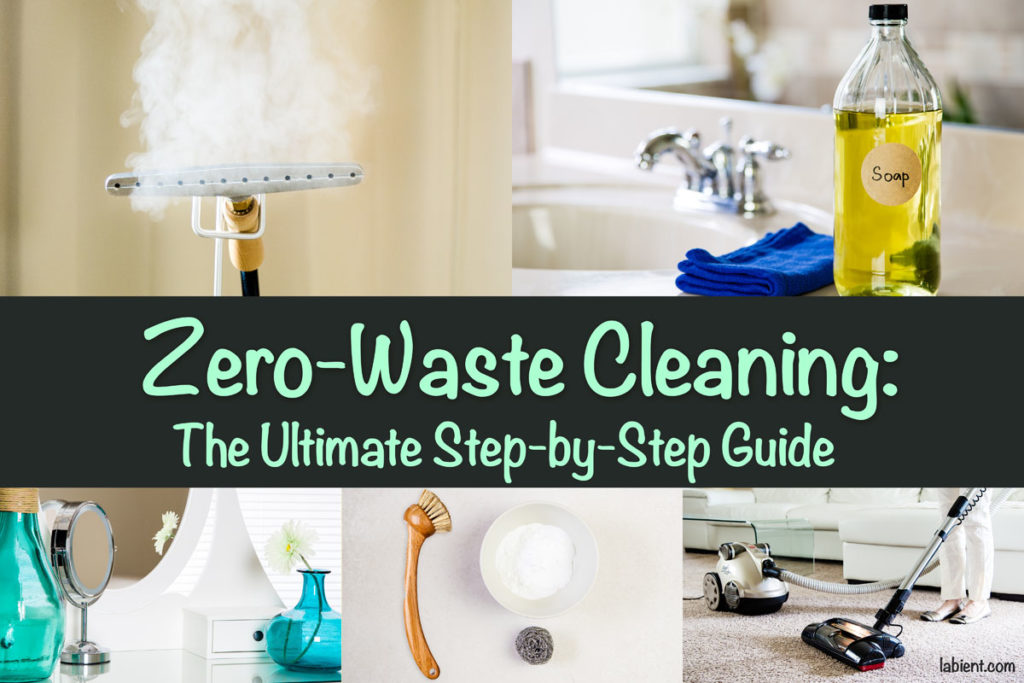Are you fed up with your traditional cleaning that creates lots of waste and makes your home toxic?
A zero-waste cleaning routine is more sustainable and eco-friendly.
It will remove toxins from your home, which in turn will reduce allergies and other health issues.
As an added bonus, it will save you money and make cleaning easy and fun.
This guide is about zero-waste cleaning, but I want to start by talking about a cleaning routine.
You’ll be struggling with zero-waste cleaning if you clean on an ad-hoc basis, just before your in-laws’ visit.
Why? Because it’s going to be hard to get layers of dust and gunk off without harsh cleaning chemicals and microfiber cloths.
The importance of a cleaning routine
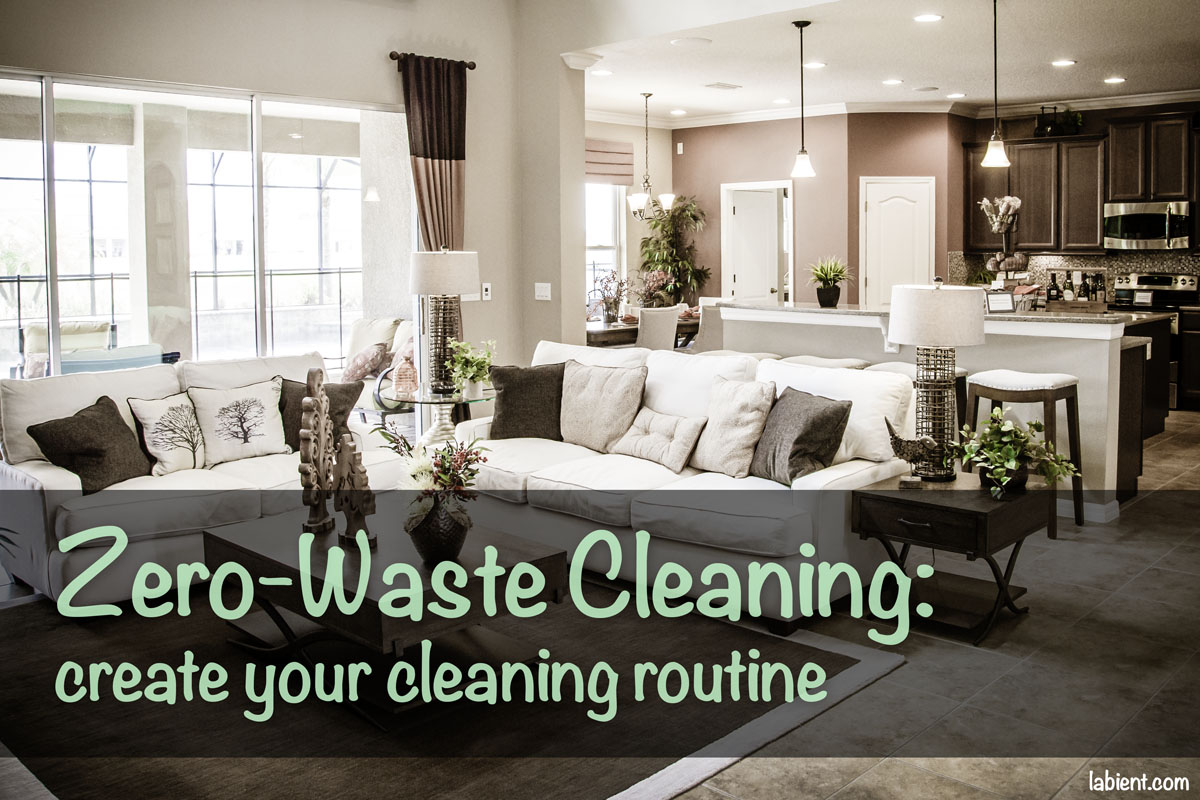
Think about a moment when you got inspired and cleaned your entire house. After hours of hard work and sweat, you sit on your sofa with a drink in hand. Happy and content, you are taking in the view of your spotless, fresh smelling home. It feels so good. You tell yourself: “This is how I will keep my home from now on!”.
Now, if you are like the many of us, you didn’t keep that promise. A few weeks passed by, and your home returned to its former state of messiness. Followed by frustration, disappointment, and a new heroic battle to restore the order. The order that doesn’t seem to last long.
Do you see the pattern? Do you tell yourself that you are a hopeless case? That you will never be able to live in a clean and organized home? Other people manage to keep their homes in order, but not you? A dream of a clean home is just a dream?
Cleaning routine is the key
Well, let me tell you that the only thing that keeps you from having that home of your dreams, is routine. People with clean homes don’t have more time, willpower or weird obsession with cleaning. No, the only difference is that they have created a cleaning routine.
The only reason that your teeth are in good condition is that you brush them twice a day. Routines keep our lives spinning, without them we wouldn’t be able to survive.
Routines keep our lives spinning, without them we wouldn’t be able to survive.
How to create a cleaning routine
It takes about two months to form a new habit. Any kind of habit, including the habit of organizing. Once you have nailed your new habit, you will perform the task on auto-pilot, without much effort. You will feel that your house cleans itself.
Decide on the first task that you want to add to your routine, and work on it for two months.
For example, start by cleaning up the kitchen after dinner. Beginning your day in a clean kitchen will give you a boost of positive energy. Also, it will motivate you to continue to keep your house organized for the rest of the day.
After you’ve mastered your first habit, add another one. It’s important to not add too many things at once, and instead, focus on nailing one task at a time.
Take it slow
It can be tempting to get it done all at once, but please be patient and focus on ONE THING at a time. Otherwise, you risk burning yourself out before your routine has become a habit.
Remember, your willpower runs out fast, and habit is the only thing that will keep you going in the long run. But you need to give the habit time to form.
Here is a video that will give you some ideas on how to structure your weekly cleaning routine:
You can also check out the evening and morning cleaning routines from the same channel.
Now that you have the tools to actually stick to your cleaning schedule, let’s dive in how you can clean your house without producing toxic waste.
Power-Steaming
Before we get into dusting, mopping and the like, let me introduce you to the secret magic wand of zero-waste cleaning: steaming.
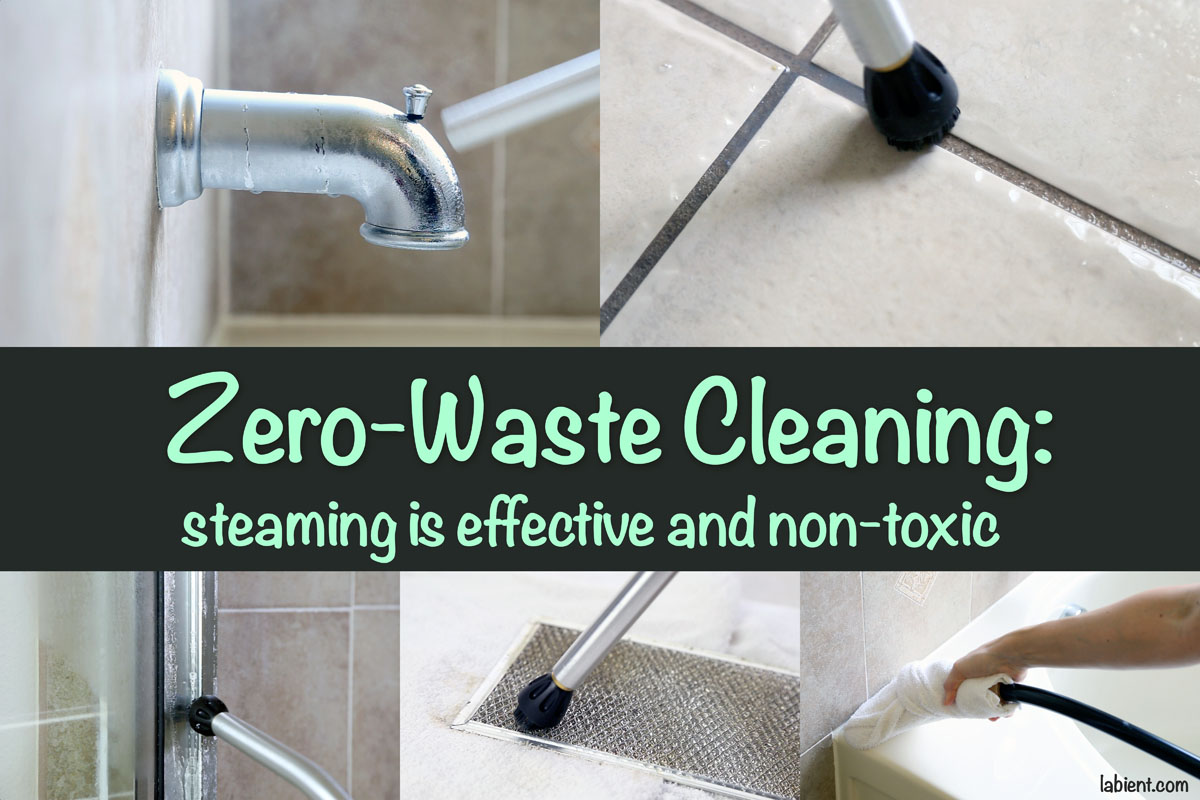
No cleaning products
No matter how earth-friendly your cleaning products are, just by using them you are producing waste.
You flush the products into the water stream and throw away the containers they came in. Don’t fool yourself that your containers are made of glass, carton, or recyclable plastic. The process of recycling is not zero-waste.
With steam, there is no need to use cleaning products at all. All you need is a stream of steam and a cloth to wipe the dirt.
Disinfect safely
Sometimes we hear arguments against eco-friendly products that “they don’t kill all the germs”. Usually followed by a statement that nothing can beat the almighty bleach.
Well, when you blast your surface with a 212°F steam, the germs die. And unlike bleach, inhaling steam doesn’t give you chemical burns and other, more serious health problems.
Steam Cleaning Uses
Here are some of the things that you can clean with steam:
Kitchen:
- Remove grease from kitchen appliances such as microwave, stove, dishwasher, exhaust fan
- Disinfect your kitchen countertops and sink
- Disinfect cutting board after handling raw meat, chicken, and fish (no breach needed!)
Bathroom:
- Disinfect shower, toilet, bathtub
- Clean tile grout
General Uses:
- Disinfect and refresh your mattress
- Disinfect and refresh carpet
- Clean windows
- Clean tile grout
All-in-One Steamer
Whatever you do, don’t get one of those $20 “as seen on TV” steamers. If you do, prepare to face lots of frustration. These cheap steamers don’t generate enough steam, leak, and break. You will end up tossing them every 6 months, which is bad news for the environment.
Personally, I appreciate multi-tasking tools. Not only do they save you money, but they take up less space because you only need to store one item instead of several.
I bought this Jiffy steamer several years ago. It works both as a general cleaning steamer and a garment steamer.
It’s made in the United States and built to last for decades. I read reviews from people who have owned it for more than 15 years and it works like new.
This long-lasting solution will not only save you money in the long run but will put less trash in landfills.
The steamer is not made of cheap plastic. The hose is made of heavy-duty rubber and the handle is wooden. It has a multitude of metal attachments that you can swap for different jobs.
If you decide to get it, make sure that you get the multipurpose J-2000i model. It comes with several attachments that you can swap and replace.
If you are only interested in steaming your clothes, draperies, and mattresses, you can go for a cheaper J-2000 model (it’s even cheaper on Amazon).
But, if you later decide to get attachments for grout and general cleaning, you will need to get a new hose. And it will set you back around $70.
Dusting
Paper towels are the most wasteful way of cleaning, and you know it. If you are using paper towels, start to phase them out and replace with reusable cloths.
If you love microfiber cloths, I have some bad news for you: microfiber is not biodegradable.
It’s a better choice than paper towels, but you will eventually have to toss your old microfiber. They will end up in the landfill, where they will hang around for a while.
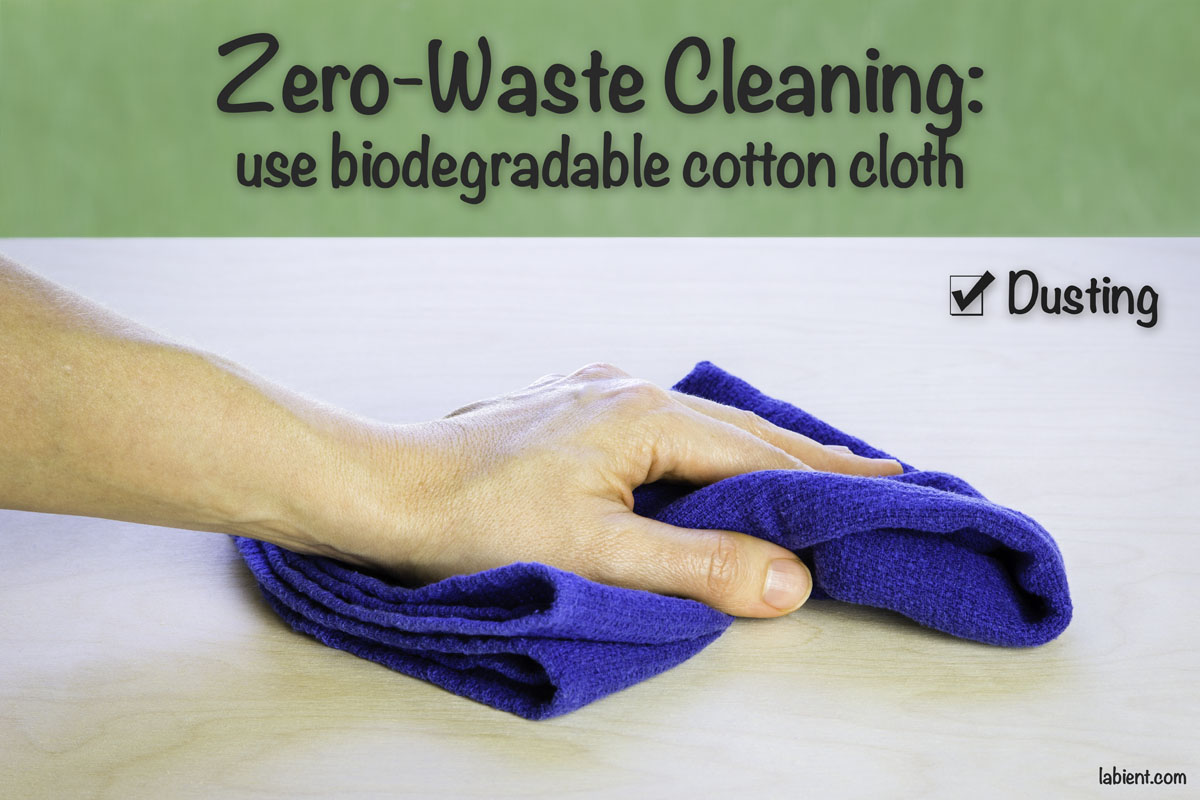
Dusting Cloth
What should you use instead? Biodegradable fabric, such as cotton, is a much better choice for our Mother Nature. I mentioned huck towels in my zero-waste kitchen guide. They are durable, lint-free, and excellent for cleaning all around the house.
You may say that microfiber works much better at absorbing dust, and it is true. But, you have created a cleaning routine, remember? When your cleaning routine is in place, your house will never get so dusty that you will need to use microfiber. Wiping your dust with a damp cotton towel will do the job.
A more sustainable way to dust your home is to repurpose your old bath towels as dusting cloths. You can cut your old towels into squares, and get soft, super absorbent, and free dusting cloths! As an added bonus, you don’t need to worry about how to dispose of your old towels.
What about a cleaner?
I don’t use any chemicals when dusting: a damp cloth does the job.
If you would use a cleaner, you would need to worry about how that chemical will react with the surface. For example, vinegar is an acid, and it will etch wood and natural stone. Soap can leave a residue if not wiped off with a clean cloth.
You can make your life simpler by just using plain water for your dusting.
Mirrors and Glass Cleaning
Mirrors and glass can be quite unforgiving to bad choices of cleaning supplies. Streaks and pieces of fiber spread around the glass is not a pretty sight. What can replace the winning combination of paper towels and Windex?
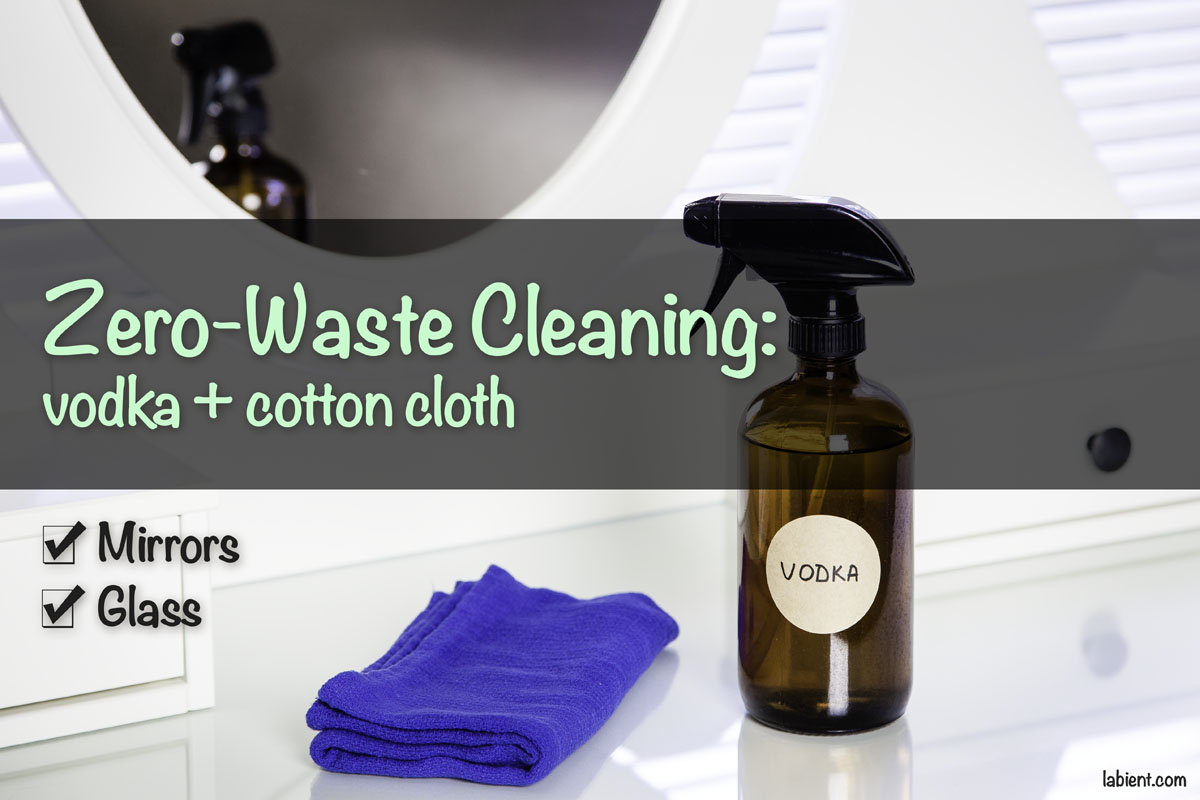
Once again, huck towels to the rescue! Since they are lint-free, they work great on glass and mirrors. Your old towels, softened by years of washing, is an excellent choice, too. Remember to wash them without softener, as it can reduce the absorbency of your towels.
If you haven’t heard about it already: vinegar is an excellent glass and mirror cleaner. It works as well as a commercial product, but it’s cheap and non-toxic.
There is only one thing that bothers me with vinegar: the fact that it is usually sold in a plastic bottle. If you can get your hands on a supplier that uses glass packaging, or refill your own container, great! If plastic is your only option, go with recyclable plastic and buy the largest bottle that you can. You will waste less plastic in the long run.
A good alternative to vinegar is, surprisingly, vodka. It works just as good, and you can buy it in a glass bottle. The drawback of vodka is that it’s usually more expensive than white vinegar.
Both vinegar and vodka can be diluted with water at a 1:2 ratio (1 part vinegar/vodka and 2 parts water). Once you’ve decided on your cleaner of choice, put it in a spray bottle, spray it on, and wipe away!
Vacuum Cleaning
My dream house has waterproof floors with drains built in. Just like in a commercial kitchen, I can clean the floors by flushing them with water and letting them dry.
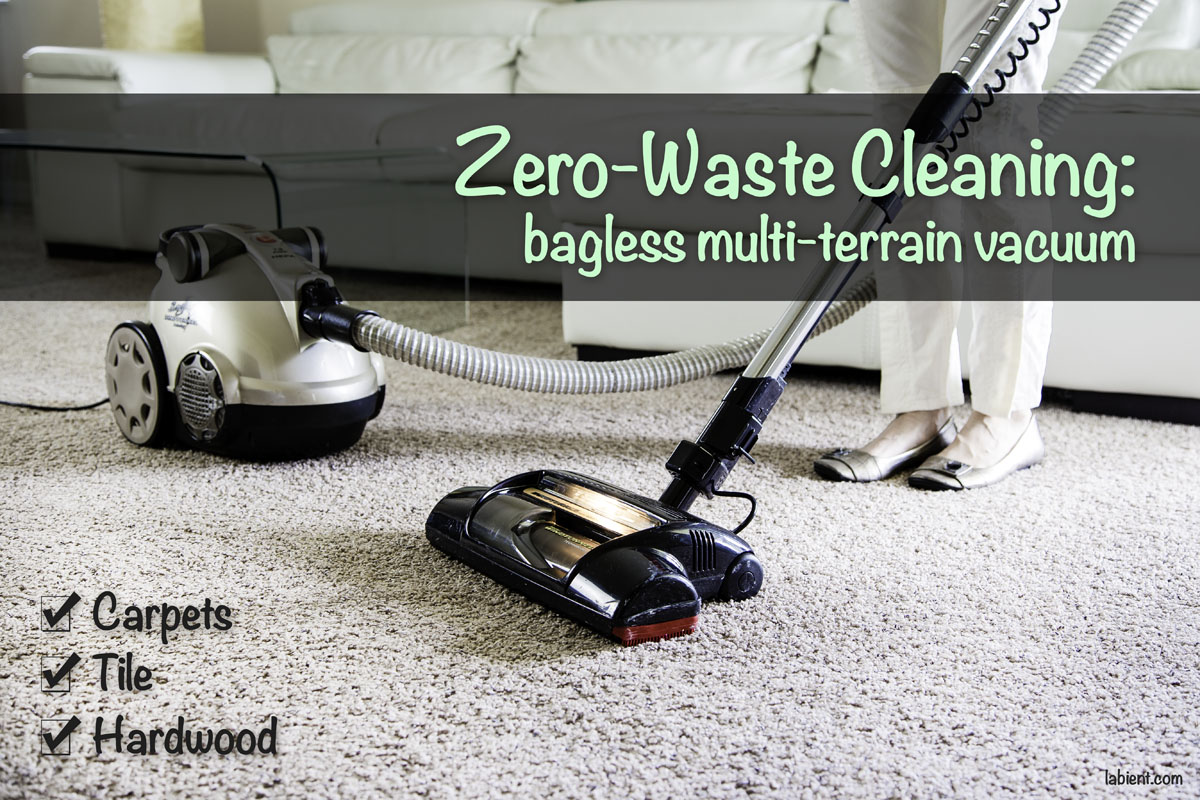
While I am waiting for that dream house to come my way, I am stuck using a vacuum cleaner. Which is not too bad, assuming that I’ve invested in a good vacuum cleaner that will last for many years.
Yes, the best way to save money and the environment is to invest in good quality products. A good vacuum cleaner can last well over a decade, while a crappy one may need to be replaced every 2 years.
That’s 5 vacuum cleaners sent to landfill per decade, instead of one (a very good one!).
There are 2 things to keep in mind when choosing your vacuum cleaner, besides its durability:
- Bagless. Getting a vacuum cleaner that uses bags means buying into an expensive bag subscription. You will save a lot of money on the bagless version. Since you can compost the dust, a bagless vacuum is a great choice for going zero-waste.
- Multi-terrain. You will be living with your vacuum cleaner for a long time (at least that’s the plan). You may not always be living in the home you are in now, and your new home may have a different type of floor. Even if you plan to stay in your house for the rest of your life, you may decide to upgrade the floors. If your vacuum only works on carpet, and you move to a house with hardwood floors, you will have to buy a new vacuum.
We bought this Hoover vacuum 7 years ago, and it served us well during many moves and different types of floors. It has a motorized carpet brush, a regular hard floor brush, and a motorized brush head for stairs.
Floor Mopping
The worst choice for a floor mop is one that comes with single-use washing pads. You may need to use several wipes per cleaning session, which is wasteful.
If you own a Swiffer, and if you don’t mind to continue using it, you may want to make your own reusable pads.
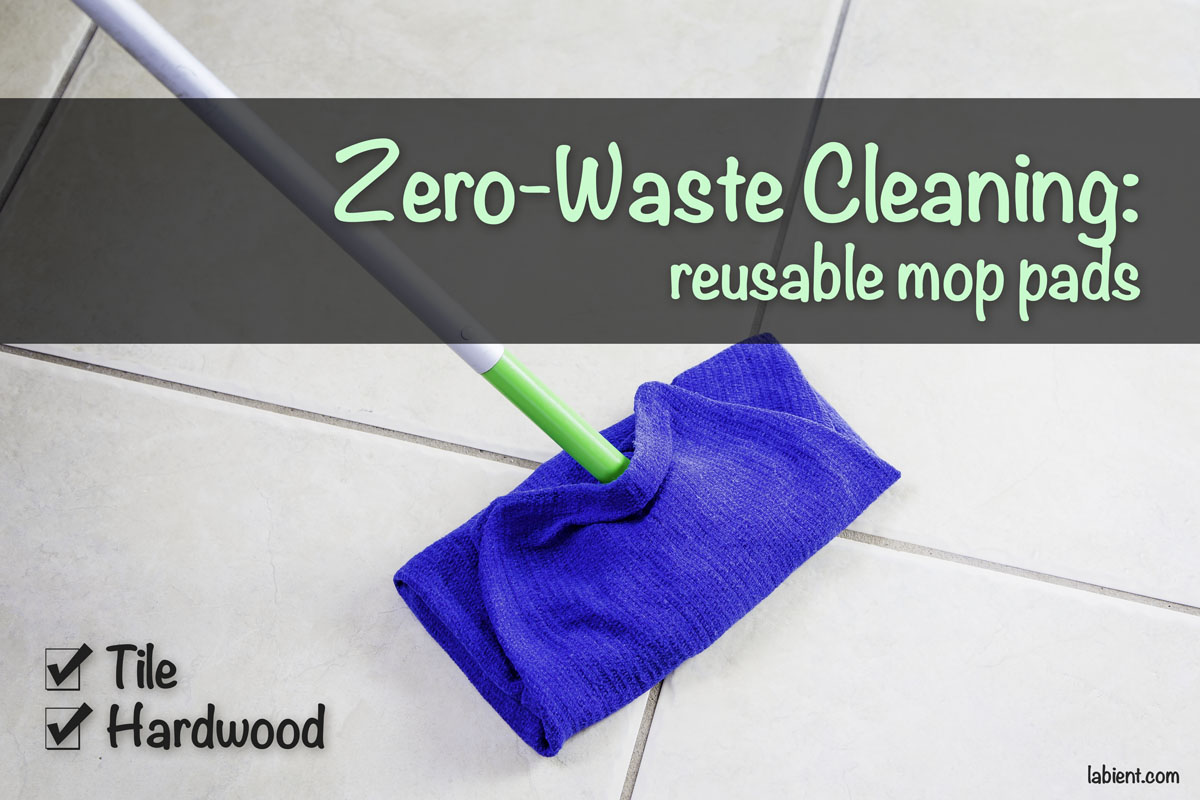
Get creative, use materials that you already have at home, like old towels. Here are some ideas to get your creative juices flowing.
The bottom line: if you already own a mop and are happy with it, the best option is to continue using throughout its full lifecycle. This will be better than throwing it out and buying something else.
But, if the time has come for you to get a new mop, read on.
A sustainable, plastic-free mopping solution
I love modular designs. Instead of buying a “one-piece” product, you assemble it from separate parts the way it fits you. For example, you start with a mop handle. Then you decide on the mop frame that best fits your needs. And lastly, you pick your mop pad.
At any time, you can replace any of these parts without having to toss the whole system into the trash.
Also, you can take it to the next level: get two mop frames, in different widths, and use the same mop handle. You can quickly switch between them based on your floor. Use the shorter version for tighter spaces, and the longer one to cover large areas such as the living room.
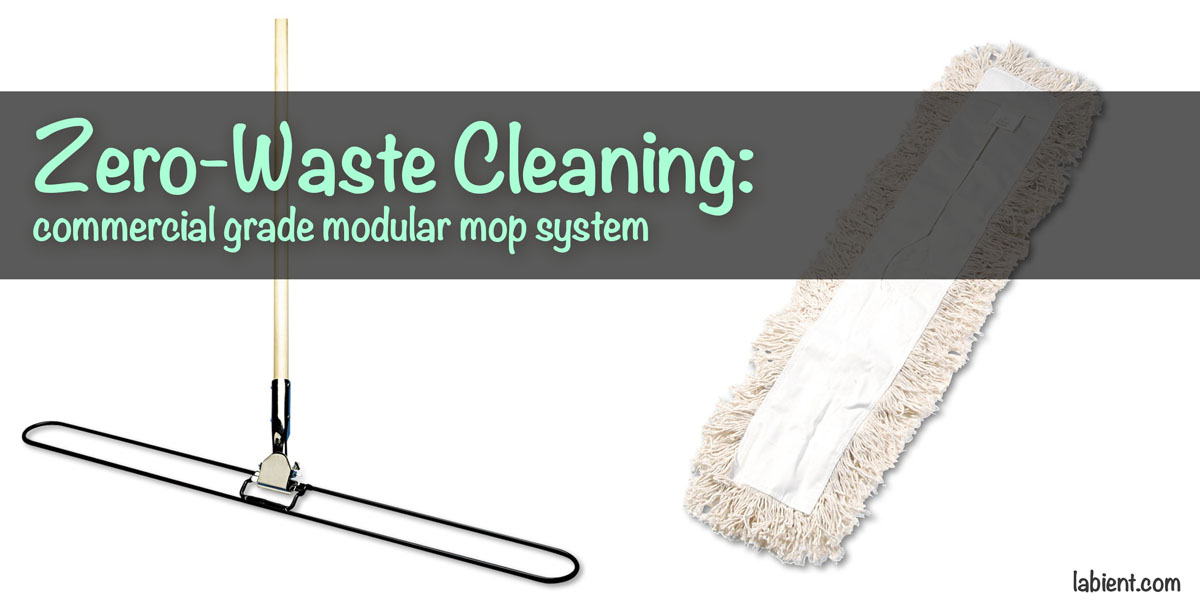
I recommend investing in a commercial grade mop. It’s more ergonomic than the cheap plastic versions sold to consumers and will last you forever.
For example, a UNISAN system provides a wooden and metal mop handle, a metal mop frame, and cotton mop pads. No plastic parts whatsoever!
Carpet Washing
We moved recently, and our new house has wall-to-wall carpet everywhere.
I was curious to see how much dirt we “inherited” from the previous owners. Instead of tossing the dirt from the vacuum, I collected it in a container.
The results were shocking. I accumulated about A POUND of dirt!
But that’s not all. We were so disgusted by the amount of dirt in the carpet, that we immediately invested in a carpet washer. When it arrived, I went ahead and washed all the floors.
The results: dirty dark gray water and more dirt extracted by the carpet washer.
Carpet washer
The bottom line: if you have carpet, vacuuming alone will not get the carpets clean. You need to power wash the carpets at least once a month to remove allergens.
Option 1: Hire a company
Hiring a company to do your carpets for you is an option, a quite expensive option. An average price to clean a 2,200 square-foot home is $362, according to Angie’s list. Also, the cleaning company will infuse harsh chemicals into your carpet: thanks but no thanks.
Option 2: Rent a carpet washer
Another option is to rent a carpet washer. Cheaper than hiring a company, but it will still set you back $30-60 every time. You will need to pick up and drop off a big and heavy machine, which can kill your motivation pretty fast.
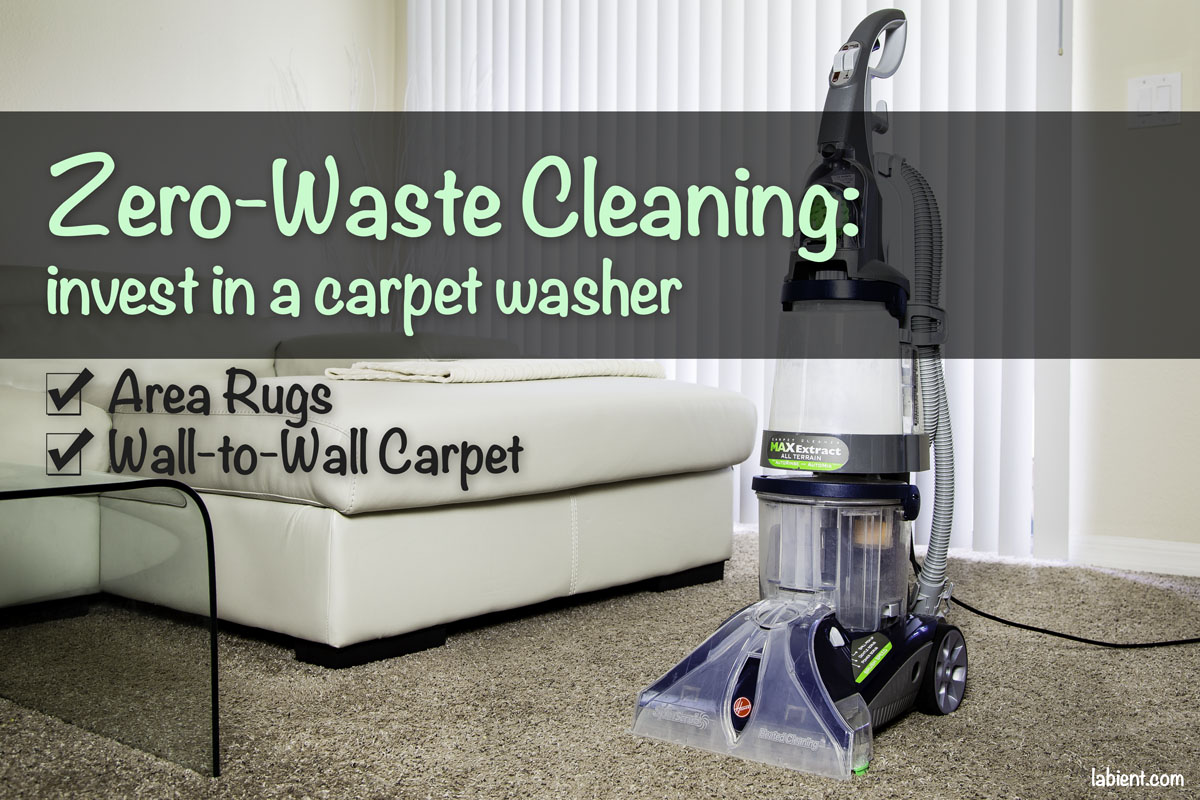
Option 3: Invest in your own carpet washer
Owning your own carpet washer will save you money in the long run and will help you stay on top of your cleaning. It’s easy to roll out the washer while you are cleaning your house. Much easier than to call and schedule a cleaning service, or drive to a nearby store to pick-up it up.
The carpet washer that I picked is an all-terrain, which means that it can clean hard floors like wood and tile. I wouldn’t buy it for that feature alone, but it’s nice to be able to sweep it across my tile floors while I am doing carpet.
Carpet cleaning solution
Now, as long as you invest in a good carpet washer, it will last you for many years. But, unless you are happy using water alone, you’ll need a cleaning solution.
Commercial carpet cleaning solutions are highly toxic. On top of that, they are expensive. A bottle of such cleaner costs around $18 and let me tell you: to clean the whole house you’ll need several of them.
If you see carpet washing as something you do once a year, it may be OK. After seeing how much dirt these carpets accumulate, once a year may no longer be an option.
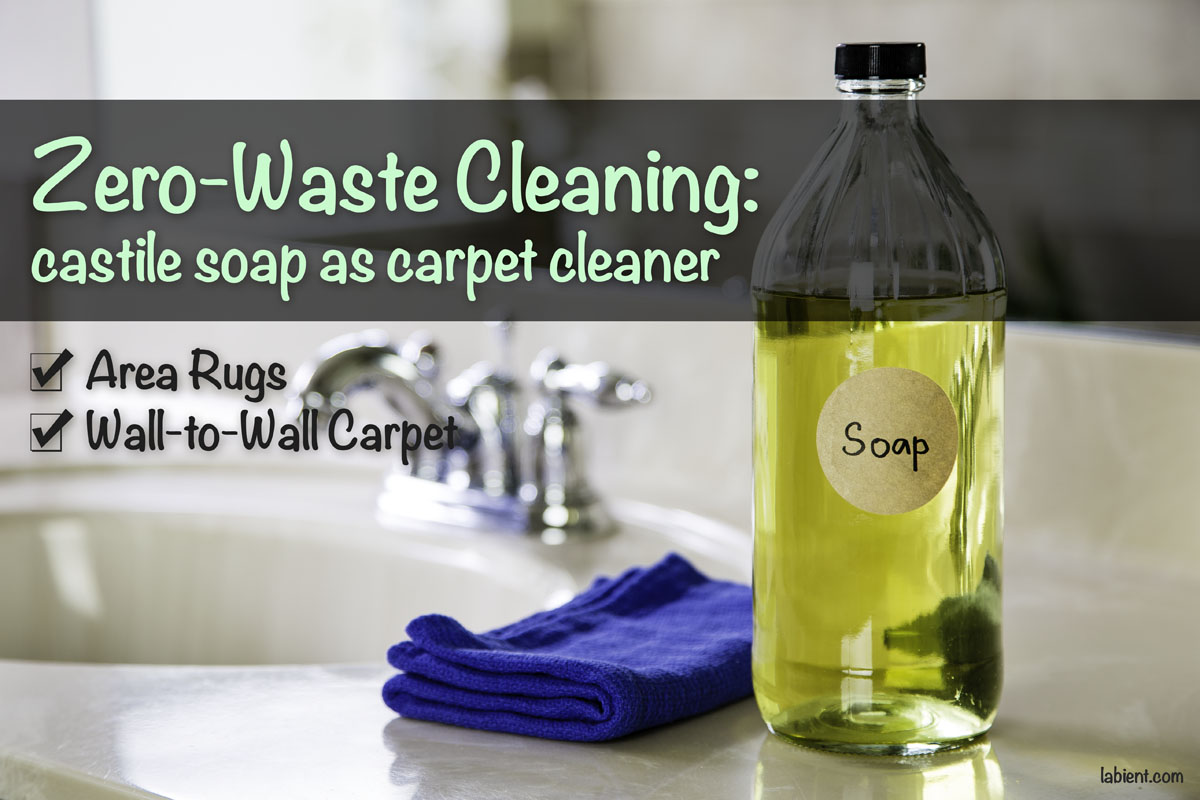
What can you do? After some online research, I found that Dr. Bronner’s Sal’s Suds was a good option. I had a bottle of it and tried using it with good results. But, it comes in a plastic bottle, and for that reason, I am not going to repurchase it.
As I mentioned in my 8-Item Self-Care Routine for a Zero Waste Bathroom, the best zero-waste option is to make your own liquid soap.
You can source all the oils in glass containers. The only ingredient that you’ll have to buy in a plastic container is lye. But, one bottle of lye will last you for many gallons of soap.
You may feel intimidated attempting to make your own soap. I felt the same. To my surprise, the process was much easier than I expected. By following this recipe my first batch turned out perfect.
Carpet disinfection

Another advantage of owning a multi-task steamer is that you can disinfect your carpet without using harsh chemicals. The hot steam will kill dust mites and other unwanted house guests. If you have a toddler or pets, it will give you a peace of mind knowing that they are crawling on a clean carpet.
The Jiffy Steamer has a carpet attachment that lets you cover larger areas of carpet at once. After treating your carpet with steam, let it dry completely, and then vacuum to remove the dead dust mites.
Bathroom Cleaning
You don’t have to buy any special tools and cleaners for the bathroom.
The beauty of your universal cleaning setup is that you can create any cleaning solution based on a handful basic ingredients. You can get your bathroom squeaky clean using the ingredients that I already mentioned above.
Here’s how you can do it:
Mirrors, Countertops, Glass shower walls, Toilet bowls
The advantage of using vodka (or rubbing alcohol) instead of vinegar as your cleaner, is that vodka can be safely used on porous surfaces such as natural stone.
Like vinegar, it is a disinfectant, but unlike vinegar, vodka is a powerful degreaser. It makes it a truly universal cleaner, eliminating the need to keep separate cleaners for different surfaces.
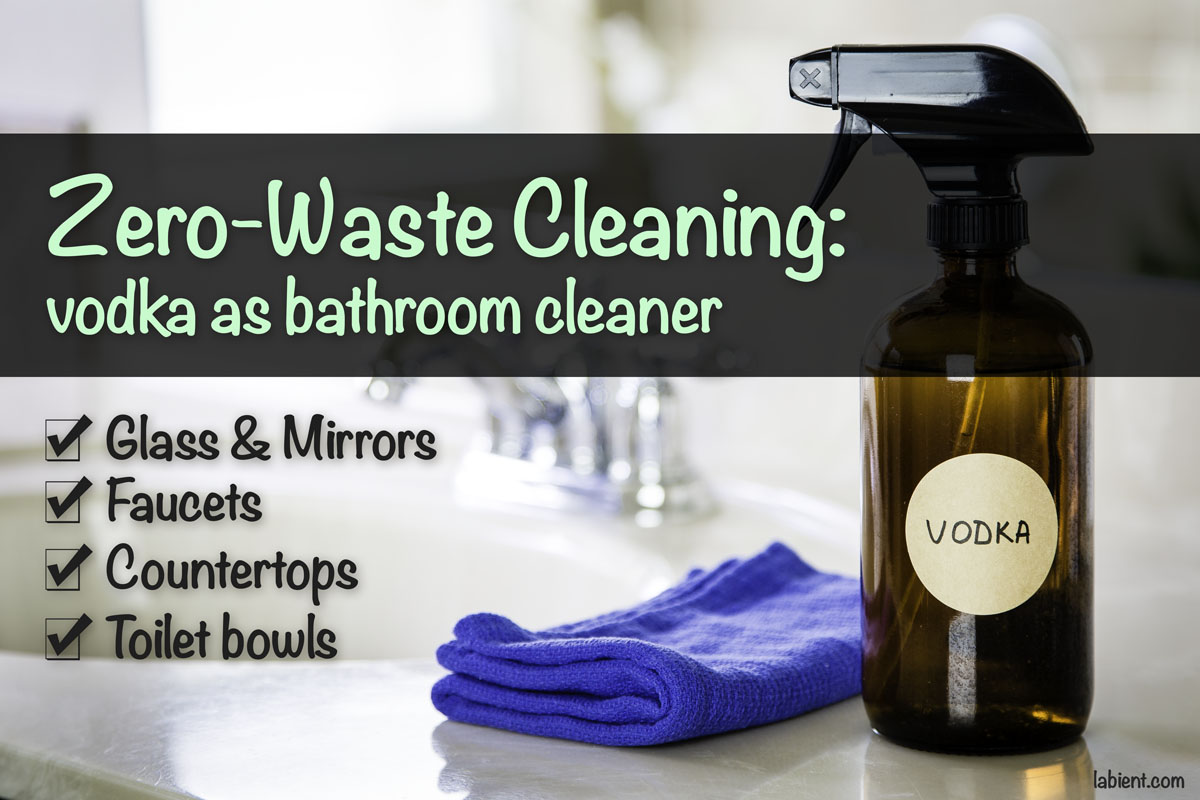
Use your trusty vodka and water solution to clean mirrors, shower glass doors, faucets, fixtures, countertops, and toilet bowls. It will clean and disinfect at the same time, leaving the surfaces shiny and streak free.
If you decide to go with vinegar instead, remember to not use it on natural stone and brass fixtures, as the acid in the vinegar will damage them. If you have said surfaces, apply a solution of Castile soap and water instead.
The vinegar cleaner is perfect for cleaning of the toilet bowl as well: vinegar is a powerful disinfectant and will kill bacteria including e-Coli.
Shower Power Cleaning
Keeping your shower clean can be a tuff undertaking. Once again, prevention is key. By getting your cleaning routine nailed, you’ll spend less time scrubbing the build-up prevent mildew and mold from growing.
Here are the steps to a clean shower:
Each time you shower:
- Step 1: Squeegee the shower wall to remove the excess moisture
- Step 2: Spray the walls with vinegar solution to prevent the growth of mold and bacteria, and prevent water spots

Once a week:
- Step 1: Scrub the shower with a paste made of baking soda and water (optionally, you can add vinegar or hydrogen peroxide to the paste). Use a natural bristle bamboo brush for the task, as it performs better than plastic ones and is eco-friendly.
- Step 2: Use a stainless steel scourer to remove hard water stains from glass (works wonders, just make sure to wet the glass surface before scrubbing, or you risk scratching the glass)
- Step 3: Use a tile grout brush or a stainless steel scourer to scrub the grout
- Step 4: Wash away the baking soda paste
- Step 5: Use a steamer to disinfect and kill any mold pores in the grout and crevices of the shower
Bathtub
Use the baking soda paste to scrub your tub in the same way as your shower.
Kitchen Cleaning
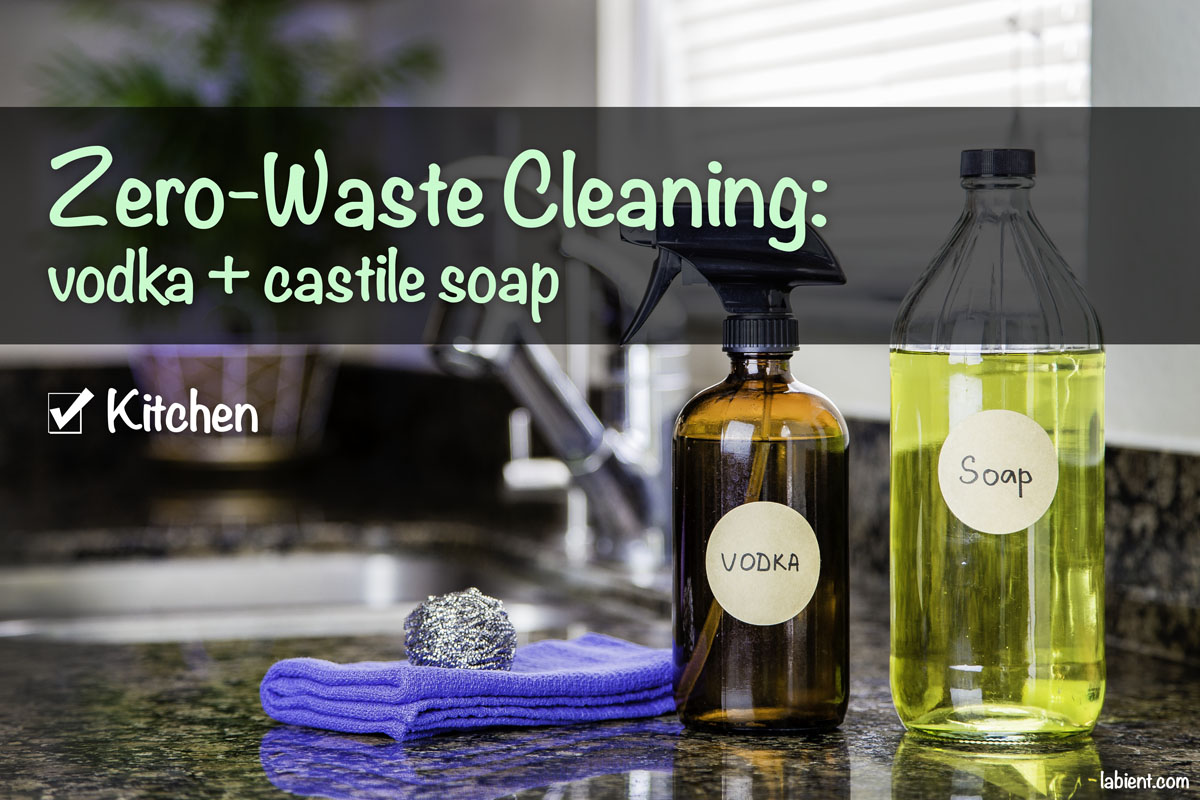
There is absolutely no need to invest in any extra tools or cleaners for your kitchen. The only thing that I do is create a mixture of Castile soap and vodka and put it in a spray bottle. I use this mixture to clean countertops, sinks, appliances, and even spray it on the floor and wipe it off with a mop.
For any tuff jobs such as ovens and oven dishes, I use baking soda mixed with Castile soap. Baking soda gives it an extra scrubbing power, and the soap removes grease and dirt. The secret here is to clean your oven regularly, at least once a week. By doing so, there won’t be any heavy build up and you won’t need to resolve to using harsh chemicals.
Oven Cleaning
If an emergency happens and you get burned food buildup in your oven, the steamer will work its magic and remove it all with ease. I have done this multiple times and it works wonders every time.
The advantage of using a steamer instead of baking soda scrub is that the steamer won’t leave any residue in your oven. It can be tuff to wipe off all the cleaning solution from inside the oven, and if you don’t get everything out, it can start burning and smelling once you turn the oven on. With a steamer, it’s only water, and once dry, the oven will be clean.
Dishes
There is a plentitude of homemade dishwasher detergent recipes online. For example, here is one from Wellness Mama. Unfortunately, none of them worked for me in the long run.
The first few washes, I would get amazing results, and get excited about the recipe.
But, after 10-20 washes, the dishes would start coming out dirty and stained. And it would just keep getting worse.
For that reason, I decided to abandon the homemade version and switch to a sustainable commercial alternative. The Ecover Natural Plant-based Dishwasher Powder seems to fit the bill. It’s biodegradable and non-toxic and comes in a carton packaging that you can recycle.
For handwashing, I use – you guessed it – the trusted Castile soap.
Protective Gear
When cleaning, you may want to use gloves to protect your hands. It can be tuff to find eco-friendly gloves that are waterproof. There are some biodegradabel options, but they don’t seem to be very comfortable.
Your best bet is to invest in good quality gloves that will last a long time. This way you will minimize the negative impact on the environment. I found these gloves to be comfortable, soft, and very durable.
Final Words
In this article, I gave you a large variety of options to switch to a more healthy and eco-friendly cleaning. I hope that you give them a try. If you do, please let me know how it worked out for you. Also, if you have any other tips on zero-waste cleaning, I would love to read about them.
Other articles from the zero-waste series:

